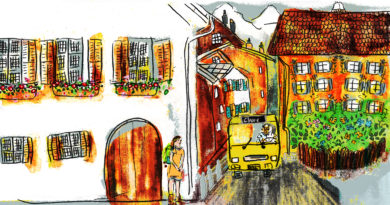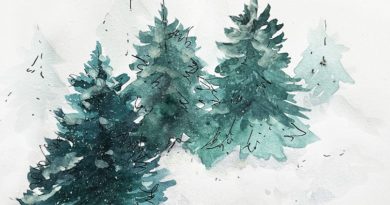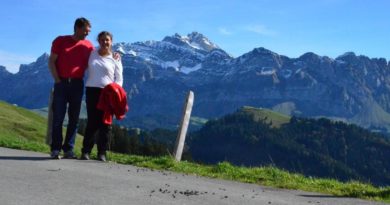The Kartause Ittingen: Spirituality, Community and Sustainability
Holidays are thrilling, extremely hectic and at times overwhelming. December is filled with shopping, children’s theatre recitals and caroling events – lots of get-togethers formal and informal. And then there is the need to travel to be with family and friends. We have family in Switzerland, England, and the USA, so deciding who to spend our holidays with is a distressing task. This year, after much discussion, our family decided to stay home this season and enjoy what our local canton, Thurgovia (Thurgau), has to offer.
Having just begun the craft-making, baking and planning for celebratory and spiritual events, I find the idea of “not travelling” appealing! Discovering local events and places of interest is not only less nerve-wracking it supports the local community and is earth-friendly. If your kids are like ours, then protecting the environment and supporting the community is on the top of their wish list this year. If not, then you can introduce them to these concepts.
One local spot we visited is the Kartause Ittingen in Warth, Thurgau. Founded in the twelve century and led by Carthusian monks from 1461 until 1521, when it was destroyed during the Swiss reformation, the monastery was rebuilt and occupied by monks until 1848, when the Council of Thurgau took over the monastery and sold it to the Fehr family. After remaining in this family for more than a century, the estate was bought by an endowment in 1977 and was completely restored between 1979 and 1983. The restoration centered on the former Carthusian monastic values: social welfare, culture, spirituality, education and self-sufficiency. It is the perfect place to wander, reflect and feel the true spirit of the holiday season, no matter your religious beliefs.
Consisting of a working farm, delightful gardens, Thurgau’s cantonal art museum, a historical museum (the Ittingen Museum), a spiritual educational centre (Tecum), and a sheltered housing and working facility, in addition to a hotel, restaurant and shop; the Kartause embodies the concepts of spiritual reflection, community and nature we are looking for this year. I think it is appropriate for families of all constellations and children of all ages.
The art museum showcases local, Thurgau, Swiss with some international art mainly from since the 1900s. The works of local artists, Helen Dahm – whom I really like – and Ernst Kriedolf (among others) are part of the permanent collection. Currently, there are two interesting temporary exhibits: “Wasser: Lebensader des Klosters” or “Water: lifeline of the monastery” and “Naktes Tatsache” or “Naked Facts.” “Naked Facts” is on until April 13th 2020 and is about changing perception of the human body throughout the last century1. The exhibit about the importance of water to the abbey runs through December. We enjoyed both exhibits immensely; they are fascinating and worth your time.
The historical museum portrays just how the hermetic and deeply spiritual Carthusian monks spent their lives at the monastery during the Middle Ages. Their focus on God as the center of all actions and their vows of strict silence and lives of self-imposed solitude are reflected in every aspect of the building: its architecture, paintings, sculptures and furniture. We were humbled by the beautiful simplicity of the monks’ cells and the symmetry of the baroque gardens.
There are exhibits, too. You can even “leaf” through manuscripts on communication screens and learn a great deal about pilgrimages and the history of the Carthusian monks and Catholicism in Europe. Audio guides in English provide details and interesting stories of the times. There is also a museum gift shop with a plethora of books and some other items.
In contrast to the monk’s cells, the exquisite and ornate chapel portrayed a sense of glory and awe. There is also a scaled-down model of the monastery and exhibits of valuable reliquaries, chalices and other church items. A visit to the Ittingen Museum certainly reinforced the idea that this holiday season is about spirituality and the need for contemplation in addition to gift-giving and enjoyment.
In addition to the museums, the cloister offers a sheltered work and living facility for individuals with mental or physical special needs. It is this social aspect of the Kartause concept that is of particular importance to our youngest son and why he always jumps at the chance to visit. Hand-made items of wood and ceramic, printed and painted objects, plants and even charcoal and firewood can be purchased there. Our American relatives enjoy the wooden puzzles, honey and nettle tea we sent. And all of my sons enjoy the Ittingen beer made from hops grown on the farm. There is also a selection of wines and gourmet cheeses, other dairy products and home-baked breads to enjoy. Our absolute favorite is the so-called “Klosterkuchen” a chocolate (either dark or milk chocolate) and hazelnut cake! The restaurant “Mühle” (Mill), has a huge running mill wheel from the nineteenth century located in one of its rooms. You can stop for a drink, a snack or a full meal. Staying true to their concept, the restaurant offers a “0 kilometer” menu, in which every ingredient is sourced locally. Over 200 ingredients are produced or worked from the farm. The apple cider (with alcohol, or without – for the grandkids) with the local cheeses from cheese maker Ruedi Tritten is a must. Because all ingredients are locally sourced and produced, shopping and enjoying these products supports the community and promotes sustainability.
There is also a hotel at the monastery, but you will need to book well in advance if you wish to stay there – it is a desirable spot for concerts and special events, like weddings and conferences.
The museums are open:
1 October until 30 April
Monday–Friday, 14:00–17:00
Saturday and Sunday, 11:00–17:00
1 May until 30 September
Monday–Sunday, 11:00–17:00
The restaurant is open:
Daily from 8:30–23:30
Text and photos by Teresa Bingham Mueller
Teresa is an earth scientist who has worked as a researcher, educator and project manager. She now works as a writer, editor and educator. She has three adult children, ages 38, 24 and 21 and two adorable grandchildren ages four and seven.
Footnote
1 The exhibit shows artistic representations of the unattired human body as paintings, drawings, sculptures, and photos.




